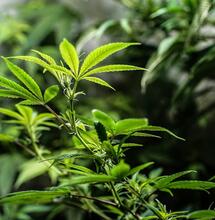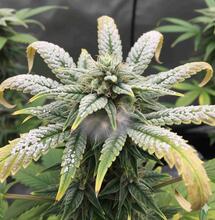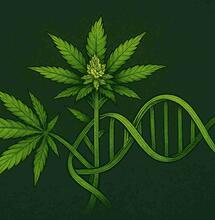Buried Treasure: Hemp Roots

Perhaps because it usually spends its days hidden beneath the soil, the humble root is vastly under-explored, compared to the other components of the plant.
Perhaps because it usually spends its days hidden beneath the soil, the humble root is vastly under-explored, compared to the other components of the plant.
Given our exhaustive use of the hemp and Cannabis plant - making use of the fiber, leaves, flowers, seeds and resin - it seems strange that there should be any element that has thus far escaped the notice of the modern herbalist. Perhaps because it usually spends its days hidden beneath the soil, the humble root is vastly under-explored, compared to the other components of the plant. However, looking at pre-prohibition medical- and veterinary literature, it is apparent that our ancestors (as with so many lost secrets and traditions) knew very well about its specific healing properties.Hemp found
The first mention of hemp root as medicine can be found in the ancient Chinese pharmacopeia, the Shen Nung Pên-ts'ao Ching, as early as the third millennium BCE. It is stated that the juice of the root has diuretic properties, as well as being useful in assisting the cessation of hemorrhage after childbirth. Beyond its use in medicine, various Chinese texts attest to the importance of hemp root in 'gunpowder' preparations - it is roasted and powdered, before being mixed with bamboo root, pine pitch and various other substances, and ignited. There are several variations on the basic recipe, which result in incendiary powders, balls for catapults (which would ignite upon impact), smoke-powders and hand-grenades. Elsewhere, it is stated that a paste made from the roots was used to relieve the pain of broken bones and surgical procedures. The Roman historian Pliny wrote in his Natural Histories, published circa 77-79 CE, that hemp root boiled in water could be used to relieve stiffness in the joints, gout and related conditions. He also noted that the root could be placed raw on burn wounds, but needed to be changed frequently to prevent drying out. Later, between the 4th and 5th centuries (CE), the Gaulish chronicler Marcellus Empiricus recorded in his opus De Medicamentis that the root was wrapped around the right arm, ostensibly as a treatment for worms. Azerbaijani manuscripts written between the 9th and the 18th centuries (CE) also attest to widespread usage of hemp root decoctions (boiled extracts) and bandages for their antiseptic and antipyretic (fever-reducing) properties, particularly in the treatment of abscesses, ulcers and toothaches. Many herbals from the medieval and Early Modern periods have survived to the present, and references to hemp abound. Mentions of the root itself are few, but there are occasional notes. The Italian herbalist, Andreas Matthioli, wrote in the Old German Neuw Krëuterbuch (ca. 1550) that poultices made from the water-soaked roots were effective against gout and arthritis, as well as ulcers of the soft tissues. In 1564, Tabernaemontanus, another Italian herbalist, made similar notes.
Plants across the ocean
A little more recently, early European settlers of the American continent brought many plants across the oceans with them, some of which were incorporated into the pharmacopeia of the indigenous peoples. Hemp became particularly important, and the root was apparently used to treat inflammation, joint pain, gout and muscular atrophy. By the later part of the 17th century, various herbals were recommending it, for the above purposes as well as to treat incontinence and venereal disease. A 1985 book by Nancy Locke Doane, which claims to be compiled from the records of her settler grandmother Minnie Susan Decker, goes into the herbal hemp remedies used during this time in some detail. In Europe, Culpeper's Complete Herbal of 1653 described hemp root as being 'a good remedy for a dry cough', and also reported it to be effective against jaundice, colic, heavy bleeding, wasting of the tendons and various other complaints. He also mentions use of the fresh root-juice to treat burns. In 1696, a German physician in the employ of the Dutch Crown, Georg Eberhard Rumpf, reported on the use of hemp root against gonorrhea in Indonesia. The 1764 New English Dispensatory recommended boiled hemp root for inflammation of the skin, a treatment long used by the people of eastern Europe. The ointment could also be used to reduce the size of tumors and break down deposits in the joints (such as those caused by gout). In the mid-19th century, a German text written by a woman named Rath Schlosser mentioned a complicated recipe in which the ashes of burnt hemp root are made into lye (sodium hydroxide, also known as caustic soda), then used to wash the hair and head - which is first covered with honey, presumably to guard against skin irritation or indeed corrosion. This treatment was believed to cause hair to regenerate - it is not clear if there is any basis for this, but their perceived effectiveness was certainly great enough that they were recorded for future generations. Perhaps their effects were coincidental, or placebo, but research may well also find that there is some truth in the folklore. Certainly traditional hemp root remedies have persisted in many countries - for example Argentina, where a 1960 study reported that the root-bark is collected in spring and boiled to make a tonic that eases dysentery and other gastrointestinal complaints. In much of the world, the main methods of preparation have been remarkably consistent through time, as have the various complaints it is credited with helping. The root is either applied raw, dried, boiled, soaked, roasted or occasionally reduced to ash. If boiled for a short time it can be drunk as a tea; if boiled for a longer time it reduces to a thick, dark extract resembling pitch or heavy oil. If it is dried - or roasted - and ground it forms a powder that can be rendered into salves or poultices; soaking it (usually after deconstructing it into its long component fibers) can produce a soothing, moist bandage for inflamed, burned or irritated skin.Research
A handful of studies look at the composition of hemp root and its medical potential. A 1971 study found that the roots contain terpenes - the fragrant resins for which Cannabis is widely known; these are the main constituents of the essential oils of many plants. Some terpenes (linked isoprene [C₅H₈] units), are thought to have a humectant, expectorant effect, which may benefit those suffering from bronchial illnesses. Friedelin is one terpene that has been definitely identified in hemp root, and has been independently found to be anti-inflammatory, antipyretic and analgesic in effect; epifriedelinol is another, present in many medicinal herbs - although its exact effect is unknown. Other research has shown that the roots contain significant concentrations of alkaloids, including piperidine and pyrrolidine, which are highly important in the synthesis of pharmaceuticals; choline, a dietary amine that is essential for the integrity of cell membranes; and atropine - a powerful alkaloid, usually extracted from the belladonna (deadly nightshade) plant, which when used as eye-drops famously dilates the pupil. When ingested as a supplement, atropine can reduce bronchial secretions, and relaxes the muscles and glands of the parasympathetic nervous system, which controls the function of most of the internal organs. It is thought to be helpful for correct function of the digestive system and kidneys, as well as sexual arousal. Hemp root has also been found to contain other alkaloid groups known as phenolic amides and lignanamides, believed to have anti-inflammatory and analgesic effects. There is some suggestion that two alkaloids present in hemp root, Cannabisativine and isoCannabisativine, adversely affect the central nervous system and are hepatotoxic (toxic to the liver). However, some research points to the existence of spermidine in these alkaloids, which has anti-aging cellular properties and may also benefit those suffering from Type II diabetes. Research into this has been limited, and it is unclear if there is an entirely safe method of ingesting hemp root extracts. The pure, boiled extract should not be taken internally, although a tea boiled for less time, as previously stated, may have beneficial effects. A 2008 study performed at Leiden University in the Netherlands, which processed hemp root with various different solvents to extract the active ingredients, found the resulting substance to be a mixture of lipids and sugars, with some other compounds mixed in. Although they acknowledge that the procedure led to various constituents being destroyed, they did discover the presence of a glycoside, a type of organic molecule that can helped to eliminate poisons from the body by binding with them chemically and rendering them inactive. The original hypothesis was that acetylcholine esterase inhibitors, which are often alkaloid, would be found in hemp root - THC itself is considered to be an important inhibitor in its own right, and the researchers believed that other similar compounds could be identified. While results were inconclusive, there is potential for future studies to be undertaken, shedding further light on the issue. [caption id="attachment_5811" align="alignnone" width="619"]
Hemp root
Currently, there are few hemp root products on the market. One exception is Hemp-EazeTM, developed by Darcy Stoddard of the Tierra Sol Farm, a small initiative based in the foothills of the Sierra Nevada mountains. Hemp-EazeTM is a range of organic creams, lotions and balms that are reported to reduce the symptoms of various conditions including eczema, psoriasis, fibromyalgia and arthritis. As well as those products designed for topical application a bath soak is also available, helpful for general aches and pains, and very soothing. There is also a spray for pets, which eases aches and pains, irritated skin and even conjunctivitis. The main ingredient in the Hemp-EazeTM range is hemp root, but there are many other natural ingredients such as feverfew, hyssop and comfrey root. For those who wish to experiment with making their own hemp root extract, there are recipes available online, or in some of the herbals mentioned previously. One recent source describes breaking up the root-mass into small chunks, then placing it into a slow cooker with water and oil in a 3:1 ratio (e.g. six cups water, two cups oil - an effective way to dissolve the active ingredients in the oil without 'frying' them), and leaving it to simmer for 12-14 hours, making sure to add water if it begins to dry out. The mixture is then strained and frozen; the oil is poured off the ice it rests upon and heated gently with beeswax until the desired room-temperature consistency is achieved. It is also possible to experiment with various other ingredients, both during the initial boiling process - where leaves and barks such as sage or cinnamon could be added - and during the final mixing stages, where it would be more advisable to use extracts and essential oils. This recipe is said to be highly effective at relieving muscle and joint pain, stiffness and spasticity when applied topically. For now, hemp root products are thin on the ground, but as research into the Cannabis plant continues apace, there will no doubt be others joining Hemp-EazeTM in their efforts to bring this intriguing root the recognition it deserves. There is definite consistency in the accounts of hemp root's importance in herbalism, throughout history and in every corner of the globe. Initial research has strongly suggested that a powerful medicine lurks below the soil that nourishes this beautiful plant, and we would be short-sighted to ignore its potential any longer. There is a use for every other part of the Cannabis plant, and those uses have been exploited increasingly intensively in recent years. Our knowledge of the medicinal properties of Cannabis is so great at this stage that it seems ludicrous that we have not explored the vast potential of the mysterious root a little more deeply.
S
Soft Secrets



